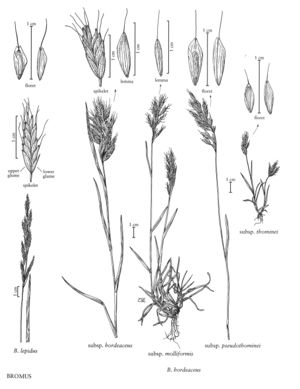familyPoaceae
subfamilyPoaceae subfam. Pooideae
genusBromus
sectionBromus sect. Bromus
speciesBromus hordeaceus
subspeciesBromus hordeaceus subsp. hordeaceus
Bromus hordeaceus subsp. hordeaceus
Treatment appears in FNA Volume 24. Treatment on page 232.
Culms (3) 10-70 cm. Panicles (3) 5-10 cm, usually with more than 1 spikelet. Lemmas (7) 8-11 mm, usually pilose or pubescent, margins bluntly angled; awns more than 0.1 mm wide at the base, straight, erect. Caryopses shorter than the paleas.
Discussion
Bromus hordeaceus subsp. hordeaceus grows throughout the range of the species, being most prevalent in southwestern British Columbia, the western United States, and the northeastern coast.
Selected References
None.
Lower Taxa
None.
"decumbent" is not a number.
... more about "Bromus hordeaceus subsp. hordeaceus"
absent +
common +
absent +
bulliform +
absent +
hairy +
acute +
absent +
absent +
unbranched +
divaricate +
straight +
distinct +
erect +
close +
free +
concealed +
hard +
thick +
parallel +
not evident +
involute +
shorter +
ascending;erect +
spikelike +
developed +
glabrous +
not branching +
annual +
climbing +
floating +
not woody +
reduced +
Colo. +, Nebr. +, Conn. +, N.J. +, N.Y. +, Wash. +, Va. +, Del. +, Wis. +, Idaho +, Mont. +, Oreg. +, Wyo. +, Pacific Islands (Hawaii) +, N.Mex. +, Tex. +, La. +, N.C. +, Tenn. +, Pa. +, Okla. +, Calif. +, Nev. +, Mass. +, Maine +, N.H. +, R.I. +, Alaska +, Ill. +, Utah +, Ark. +, Ind. +, Iowa +, Ariz. +, Md. +, Ohio +, Mo. +, Mich. +, N.Dak. +, S.Dak. +, Kans. +, S.C. +, Ky. +, Alta. +, B.C. +, Greenland +, N.B. +, Nfld. and Labr. (Labr.) +, N.S. +, N.W.T. +, Ont. +, Que. + and Yukon +
1/6 +
capillary +
adjacent +
sometimes longer +
bisexual +
1-9(11)-veined +
lanceolate +
subtending +
absent +
1/4 +
unequal +
equal +
uncinate +
punctate +
Present +
compound +
reduced +
absent +
rounded +
absent +
distichous +
7-9-veined +
adjacent +
lanceolate +
absent +
hairy +
obtuse +
membranous +
not veined +
truncate +
inconspicuous +
glabrous +
lanceolate +
3-5-veined +
pilose +
hyaline +
angled +
not inrolled +
simple +
absent +
well-developed +
usually shorter +
absent +
keeled +
reduced +
3 cm30 mm <br />0.03 m <br /> (?) +
dense +
erect +
ovoid +
reduced +
absent +
separating +
absent +
open +
concealed +
prolonged +
evident +
open +
closed +
full +
pubescent +
Introduced +
ebracteate +
mixed +
attached +
not viviparous +
parallel-sided +
Bromus hordeaceus subsp. hordeaceus +
Bromus hordeaceus +
subspecies +
hyaline +
membranous +
1 cm10 mm <br />0.01 m <br /> (?) +
5-7-veined +
converging +
absent +
rhizomatous +
